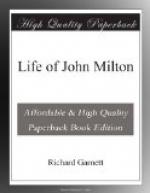A more important work, though scarcely worthy of Milton’s industry, was his “History of Britain” (1670). This was a comparatively early labour, four of the six books having been written before he entered upon the Latin Secretaryship, and two under the Commonwealth. From its own point of view, this is a meritorious performance, making no pretensions to the character of a philosophical history, but a clear, easy narrative, sometimes interrupted by sententious disquisition, of transactions down to the Conquest. Like Grote, though not precisely for the same reason, Milton hands down picturesque legendary matter as he finds it, and it is to those who would see English history in its romantic aspect that, in these days of exact research, his work is chiefly to be recommended. It is also memorable for what he never saw himself, the engraved portrait, after Faithorne’s crayon sketch.
“No one,” says Professor Masson, “can desire a more impressive and authentic portrait of Milton in his later life. The face is such as has been given to no other human being; it was and is uniquely Milton’s. Underneath the broad forehead and arched temples there are the great rings of eye-socket, with the blind, unblemished eyes in them, drawn straight upon you by your voice, and speculating who and what you are; there is a severe composure in the beautiful oval of the whole countenance, disturbed only by the singular pouting of the rich mouth; and the entire expression is that of English intrepidity mixed with unutterable sorrow.”
Milton’s care to set his house in order extended




